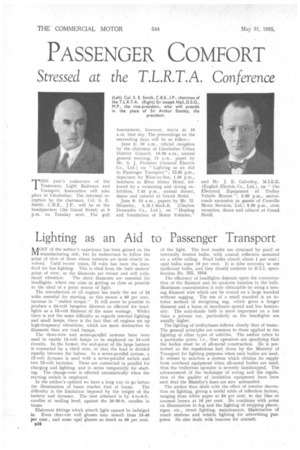Lighting as an Aid to Passenger Transport M 0ST of the
Page 52

If you've noticed an error in this article please click here to report it so we can fix it.
author's experience has been gained on the manufacturing side, but he endeavours to follow the point of view of those whose interests are most closely involved. Until recent times, 12 volts has been the standard for bus lighting. This is ideal from the bulb makers' point of view, as the filaments are robust and will with
stand vibration. The short filaments are essential for headlights, where one aims at getting as close as possible to the ideal of a point source of light.
The introduction of oil engines has made the use of 24 volts essential for starting, as this means .a 60 per cent. increase in " stalled torque." It will never be possible to produce a 24-volt tungsten filament as efficient for headlights as a 12-volt filament of the same wattage. Whilst there is not the same difficulty as regards internal lighting and small lamps, there is the fact that oil engines set up high-frequency vibrations, which are more destructive to filaments than are road bumps.
The three-wire and series-parallel systems have been used to enable 12-volt lamps to be employed on 24-volt circuits. In the former, the mid-point of the large battery is connected by a third wire, so that the load is divided equally between the halves. In a series-parallel system, a 12-volt dynamo is used with a series-parallel switch and two 12-volt batteries. These are connected in parallel for charging and lighting, and in series temporarily for starting. The change-over is effected automatically when the starting switch is employed.
In the author's opinion we have a long way to go before the illumination of buses reaches that of trams. The difficulty is the limitation imposed by the weight of the battery and dynamo. The hest attained is by 4-to-6-ft. candles at reading level, against the 20-30-ft. candles in trams.
Elaborate fittings which absorb light cannot be indulged in. Even clear-cut well glasses may absorb from 15-40 per cent., and some opal glasses as much as 50 per cent.
B34 of the light. The best results are obtained by pearl or internally frosted bulbs, with conical reflectors mounted on a white ceiling. Pearl bulbs absorb about 1 per cent.; opal bulbs some 10 per cent. It is false economy to use inefficient bulbs, and they should conform to B.S.I. specification No. 555, 1934.
The efficiency of headlights depends upon the concentration of the filament and its accurate location in the bulb. Maximum concentration is only obtainable by using a -nonsag filament wire which can be wound on a large mandrel without sagging. The use of a stnall mandrel is an inferior method of mitigating sag, which gives a longer filament and a beam of inordinate spread and low luminosity. The anti-dazzle bulb is more important on a bus than a private car, particularly as the headlights are usually higher.
The lighting of trolleybuses follows closely that of trams. The general principles are common to those applied to the lighting of other types of vehicles. The author 'refers to a particular point, i.e., that operators are specifying that the bodies must be of all-metal construction. He is perturbed at the regulations laid. down by the Ministry of Transport for lighting purposes when such bodies are used. It refuses to sanction a system which obtains its supply from overhead .equipment when all-metal bodies are used; thus the trolleybus operator is severely handicapped. The advancement of the technique of wiring and the regulation of the quality of insulation equipment have been such that the Ministry's fears are now unfounded.
The author then deals with the effect of interior decoration on lighting, giving a useful table of reflection factors, ranging from white paper at 84 per cent, to sky blue or coconut brown at 16 per cent. He continues with notes on illumination in fog and the lighting of stopping places,. signs, etc., street lighting, maintenance, illumination of coach stations and vehicle lighting for advertising purposes. He also deals with beacons for aircraft.




































































































